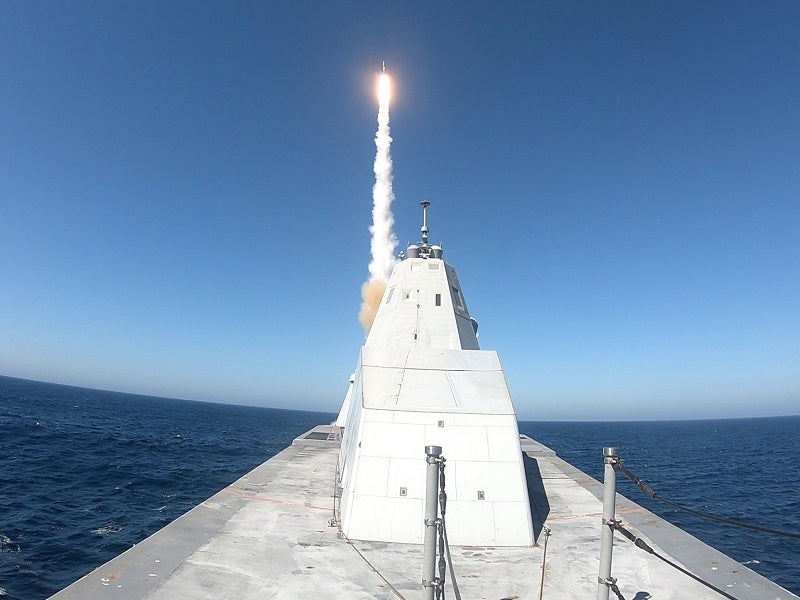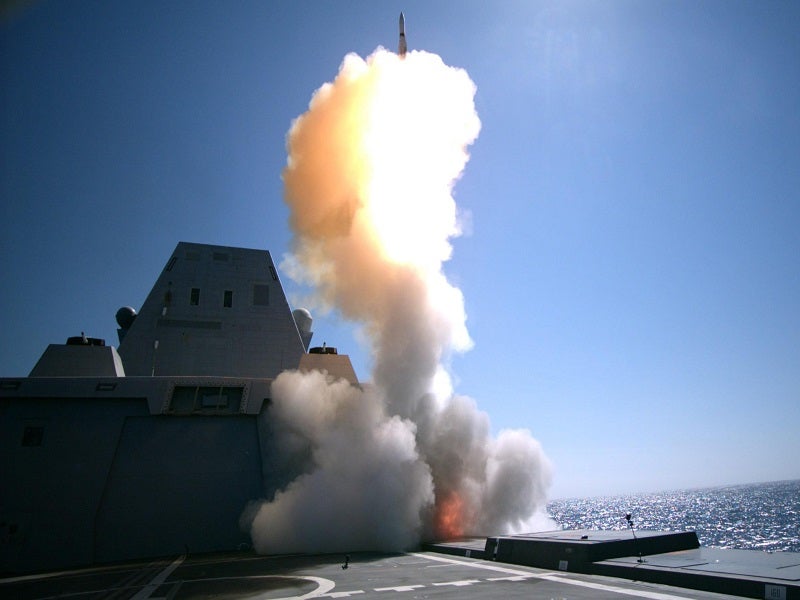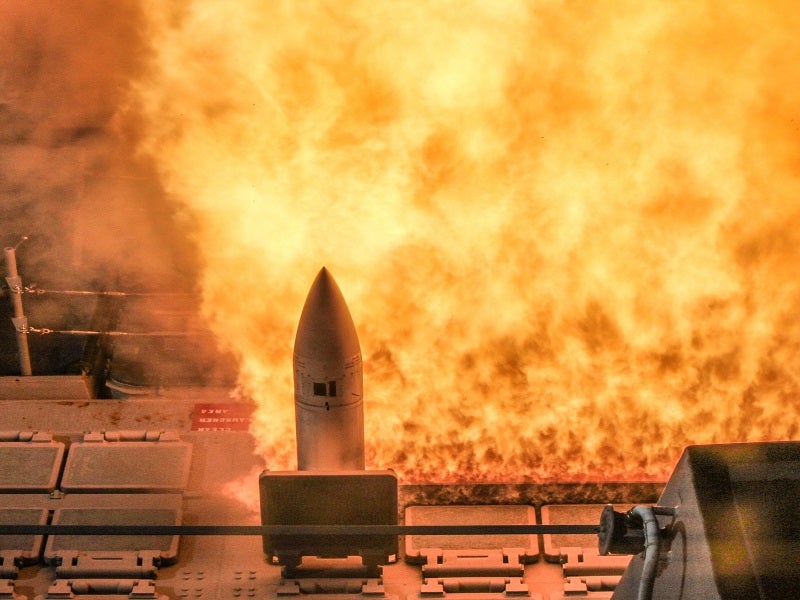Standard Missile 2 (SM-2) is a ship-launched air defence missile manufactured by Raytheon Missiles & Defense, a subsidiary of Raytheon Technologies.
The medium-to-long-range surface-to-air missile is part of the Standard missiles family, which also includes the Standard Missile-6 (SM-6). The missile provides protection against anti-ship missiles and aircraft, as well as threats flying close to the water’s surface.
The SM-2 missile in Block III, IIIA, IIIB and IV configurations is in service with the US Navy, serving as the primary air defence missile. The missile variants are also in service with 15 allied navies.
Raytheon halted production of the missile in 2013 due to a lack of international orders. Production was restarted in 2017 due to increasing global demand for the weapon.
The SM-2 Block IIIA missile was test-fired from the US Navy’s guided-missile destroyer USS Zumwalt in October 2020. An SM-2 interceptor destroyed a cruise missile target during the testing.
The Royal Australian Navy’s (RAN) guided-missile destroyer, HMAS Hobart, successfully fired an SM-2 missile against an unmanned target during trials off the coast of New South Wales in August 2019.
SM-2 has so far completed more than 2,700 successful flight tests.
Standard Missile 2 features
The SM-2 medium-range missile has a wingspan of 1.08m and overall length of 4.72m. It has a diameter of 34.3cm and weighs 708kg.
The missile is part of the Aegis combat system, an integrated naval weapon system that uses SM-2, SM-6, Evolved SeaSparrow Missile (ESSM) and other defence systems to defend naval ships against hostile aircraft and cruise missile threats
Aegis is integrated on the US Navy’s Ticonderoga-class guided-missile cruisers and Arleigh Burke-class guided-missile destroyers, as well as frigates and destroyers of allied navies, including those of Australia and Japan.
The SM-2 missile is armed with a blast-fragment warhead integrating a radar and contact fuse.
Launchers for SM-2
SM-2 can be launched from the MK 41 vertical launching system (VLS), which features a modular configuration and supports continuous development.
To fire the SM-2 missiles, the RAN modified the Mk 13 launchers and Mk 92 fire control system (FCS) fitted to its Adelaide-class frigates.
A contract worth $20.6m was awarded to Lockheed Martin to upgrade the MK 92 FCS in September 2007.
The Adelaide-class frigates were replaced by Hobart-class destroyers. The final two Adelaide-class frigates were transferred from the RAN to Chile in 2020.
Guidance system
The Block IIIA and IIIB variants of the weapon system incorporate radar seeker technologies in two guidance modes, namely continuous wave and interrupted continuous wave. Furthermore, the Block IIIB variant is equipped with autonomous infrared acquisition capability.
The SM-2 missile is installed with an upgraded semi-active radar homing seeker guidance system.
Mission capabilities
SM-2 is primarily deployed for fleet area air defence and ship self-defence. It can also be used as an anti-surface warfare missile.
The Block III/IIIA/IIIB variants are medium-range, surface-to-air missiles, while Block IV is designed to support fleet and extended area air defence.
Propulsion and performance of SM-2
SM-2 is fitted with tail controls and solid-fuel rocket motors for enhanced propulsion and manoeuvrability. The motors generate an upward thrust of 272kg. The extended range missile variants feature boosters with thrust vector controls.
The SM-2 missiles can achieve a speed of more than Mach 3 and hit targets at a maximum distance of 90nmi and altitude of 65,000ft.
Orders and deliveries
Raytheon Missiles & Defense received a contract worth $578m for the production of 54 SM-2 Block IIIAZ all-up round upgrades for the US along with 215 rounds for seven partner nations in December 2021.
The company is responsible for producing Block IIIA, IIIAZ and IIIB variants for the US and its partners, which include Denmark, Chile, South Korea, Japan, the Netherlands, Spain and Taiwan.
In addition, it will provide instrumentation kits, engineering services and spares as part of the contract.
The US State Department approved a potential foreign military sale (FMS) of the SM-6 and SM-2 Block IIIC missiles to the Australian Government in August 2021.
The FMS will support Australia’s future purchase of the SM-6 and SM-2 Block IIIC missiles for its future Hunter-class destroyers. Raytheon Missiles & Defense will provide services, such as engineering, integration and testing (EI&T), development, obsolescence engineering activities to ensure readiness, and logistics support.
The US Government approved a potential sale of SM-2 Block IIIA missiles and associated equipment to Chile in February 2021. The proposed sale includes 16 SM-2 Block IIIA missiles, including two missiles with installed telemeter, two MK 89 Mod 0 guidance sections and a MK 45 Mod 14 target detection device kit.
A possible sale of 100 SM-2 Block IIIC missiles, MK 13 Vertical Launch Systems (VLS), and related equipment and services to Canada for about $500m was approved by the US administration in November 2020. The Block IIIC missiles are planned to be installed on the Canadian Surface Combatant (CSC) ships, which will be built for the Canadian Navy.
The Defense Security Cooperation Agency (DSCA) notified Congress about a possible $313.9m FMS of up to 94 SM-2 Block IIIB rounds, 12 MK 97 MOD 0 guidance sections for SM-2 Block IIIB missiles, as well as related equipment and support, to the Republic of Korea (RoK) in May 2019.
A bundled contract was signed in 2017 to supply 280 SM-2 Block IIIA and IIIB missiles for Japan, Australia, South Korea and the Netherlands.
Japan requested 246 RIM-66M-09 SM-2 Block IIIB vertical launching tactical all-up rounds, MK 13 MOD 0 VLS canisters, operator manuals, technical documentation and support. The proposed sale, which is estimated at $821m, was approved by the State Department in July 2016.
The US State Department approved Australia’s request for the supply of SM-2 Block IIIB missiles, equipment and support under FMS for $301m in May 2016. The equipment and services requested by Australia included 80 RIM-66M-09 SM-2 Block IIIB vertical launching tactical all-up rounds and about 15 MK 97 SM-2 Block IIIB guidance sections. Other components of the FMS include MK 13 MOD 0 VLS canisters, technical documentation and support services.
Australia’s request for a $46m FMS of 17 SM-2 Block IIIB standard warhead-compatible telemetry missiles as well as related equipment and support was approved in October 2010.










